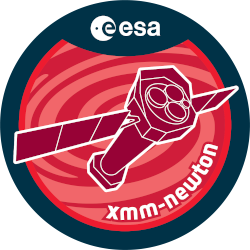

| Proposal ID | 076482 |
| Title | XMM monitoring of the newly discovered transient Magnetar SGR1935+2154 |
| Download Data Associated to the proposal | https://nxsa.esac.esa.int/nxsa-sl/servlet/data-action-aio?obsno=0764820101 |
| DOI | https://doi.org/10.5270/esa-3kbau58 |
| Principal Investigator, PI | Prof GianLuca Israel |
| Abstract | SGR1935+2154 is the latest discovered member of the rapidly increasing class ofmagnetars and has been discovered due to its transient behaviour and theemission of short and intense (F_X > 10 Crabs) bursts. We have inferred theperiod of the source (3.2s) while the first period derivative is stillundetected preventing us to infer its main parameters. Moreover, unexpectedly wefound a diffuse emission component around the pulsar. This nebula might beeither the second strongest candidate for the elusive magnetar wind Nebula or adust- scattering halo. We request two pointings of 40 and 60ks aimed at: i)inferring the main pulsar parameters, ii) monitoring its decay, iii) looking forits quiescent state, and carry out a detailed study of the extended emission. |
| Publications |
|
| Instrument | EMOS1, EMOS2, EPN, OM, RGS1, RGS2 |
| Temporal Coverage | 2015-03-25T07:31:21Z/2015-10-08T10:14:15Z |
| Version | 17.56_20190403_1200 |
| Mission Description | The European Space Agencys (ESA) X-ray Multi-Mirror Mission (XMM-Newton) was launched by an Ariane 504 on December 10th 1999. XMM-Newton is ESAs second cornerstone of the Horizon 2000 Science Programme. It carries 3 high throughput X-ray telescopes with an unprecedented effective area, and an optical monitor, the first flown on a X-ray observatory. The large collecting area and ability to make long uninterrupted exposures provide highly sensitive observations. Since Earths atmosphere blocks out all X-rays, only a telescope in space can detect and study celestial X-ray sources. The XMM-Newton mission is helping scientists to solve a number of cosmic mysteries, ranging from the enigmatic black holes to the origins of the Universe itself. Observing time on XMM-Newton is being made available to the scientific community, applying for observational periods on a competitive basis. |
| Creator Contact | https://www.cosmos.esa.int/web/xmm-newton/xmm-newton-helpdesk |
| Date Published | 2016-10-21T22:00:00Z |
| Last Update | 2025-08-04 |
| Keywords | "XMM", "iii looking", "dust scattering halo", "main pulsar parameters", "crabs bursts", "diffuse emission component", "period derivative", "strongest candidate", "main parameters", "transient magnetar sgr1935", "intense f_x", "SGR1935+2154" |
| Publisher And Registrant | European Space Agency |
| Credit Guidelines | European Space Agency, Prof GianLuca Israel, 2016, 'XMM monitoring of the newly discovered transient Magnetar SGR1935+2154', 17.56_20190403_1200, European Space Agency, https://doi.org/10.5270/esa-3kbau58 |